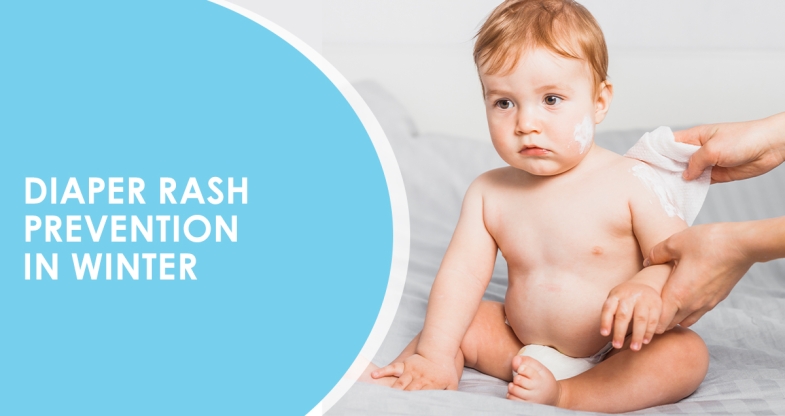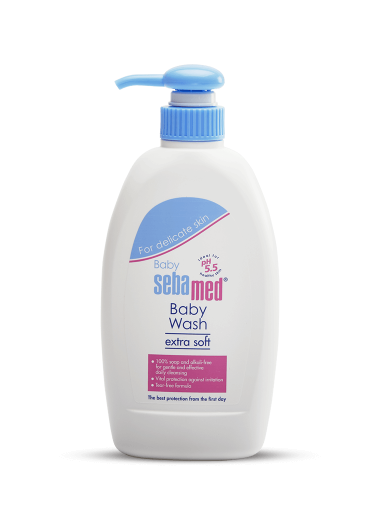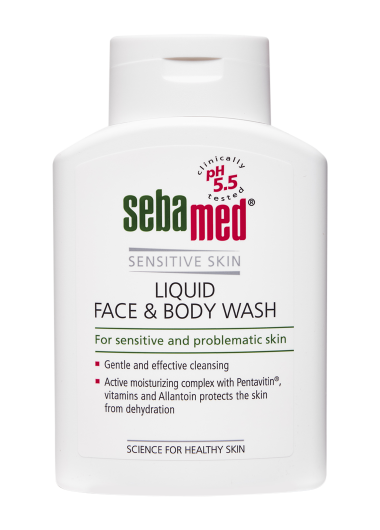Diaper Rash Prevention in Winter
by Sebamed | Dec 26, 2023

Are you struggling to keep your baby’s diaper rash at bay this winter? Chapped skin, redness, and rashes can plague your little one during the cooler months as less exposure to air and moisture causes delicate skin to become dry and irritated. Don’t worry: we’re here to help!
In this blog post, we will share our top tips for preventing nasty diaper rashes in wintertime so that your baby stays comfortable despite dropping temperatures. From skincare basics such as changing diapers frequently and using a non-harsh barrier cream to emerging methods like overnight disposable diapers or charcoal inserts, there are plenty of options available! Keep reading for more advice on how you can protect your baby from those pesky winter woes.
Index [hide]
- How To Prevent Babies Diaper Rash in Winter
- Maintain Clean and Dry Skin Around Diapers
- Keep Baby Warm and Dry
- Promote Natural Airflow
- Avoid Harsh Wipes
- Rinse with Warm Water During Diaper Changes
- Apply Diaper Rash Creams
- Check Diaper Size
- Avoid Skin Irritants
- Be Mindful of Winter Fabrics
- Maintain a Comfortable Room Temperature
- Hydrate
- Choose Diaper-Free Time
- Consult a Pediatrician
- Conclusion
- Products Mentioned in the Blog
- FAQs

How To Prevent Babies Diaper Rash in Winter
As winter brings colder temperatures, it also introduces unique challenges for baby care, including an increased risk of diaper rash. Here are some tips to prevent diaper rash during the winter months:
Maintain Clean and Dry Skin Around Diapers
Keeping the baby's skin clean and dry prevents diaper rashes. Change diapers every two hours, especially after they are wet or soiled. Clean the area thoroughly, avoiding rubbing, and pat the skin dry. Opt for disposable diapers with absorbent gel to draw wetness away from the skin.
Keep Baby Warm and Dry
Ensure that your baby is dressed appropriately for the cold weather. Use layers to keep them warm without overheating. Change wet or soiled diapers promptly. Moisture can contribute to diaper rash, so keeping the diaper area dry is crucial.
Promote Natural Airflow
Enhance the healing process by increasing air exposure to the diaper region. Allow short diaper-free periods, particularly during naps, to let the baby's skin breathe. Placing the baby on a waterproof or washable changing mat for a few minutes can facilitate proper airflow.
Avoid Harsh Wipes
Choose gentle, fragrance-free wipes for diaper changes. Some wipes may contain irritants that can be harsh on sensitive skin.
Rinse with Warm Water During Diaper Changes
Rinse the baby's bottom with warm water during each diaper change. Gently apply water using your hands, a plastic bottle, or soft washcloths. Avoid wipes containing alcohol or fragrance, and be gentle during cleaning.
Hydrate
Ensure your baby stays hydrated. Proper hydration helps maintain healthy skin, and dry skin is more prone to irritation. Sebamed Baby Wash Extra Soft has a pH of 5.5 and keeps your baby hydrated.
Sebamed Baby Wash Extra Soft, with a pH of 5.5 and a sugar-based mild cleanser, stands out as a gentle option for baby care. In contrast, many other baby cleansers with a pH greater than 7 can damage the skin's protective barrier.
A newborn's skin typically has a pH of 7 at birth, and it takes a few weeks to three months for the acid mantle, safeguarding the delicate skin, to develop, reaching a pH of 5.5. At this optimal pH of 5.5, the skin's protective barrier remains intact, minimizing lipid and moisture loss and restricting the growth of pathogenic bacteria.

Apply Diaper Rash Creams
After cleaning and allowing the skin to dry, apply diaper rash creams containing natural ingredients such as almond oil and aloe vera. These creams provide effective treatment, manage rashes, and create a protective layer on the baby's sensitive skin.
A pH level of 5.5 is crucial for Diaper Rash Prevention in Winter because it corresponds to the natural pH of healthy baby skin. Sebamed Baby Rash Cream, with its pH 5.5 formulation, helps maintain this ideal balance.
This pH level is skin-friendly and aids in preserving the skin's protective barrier, preventing dryness and irritation. Especially during winter when the skin is prone to dryness, a pH 5.5 product is beneficial as it supports the skin's natural defenses, contributing to a healthier and rash-free diaper area.
Sebamed Baby Rash Cream features a micronized form of Titanium dioxide that creates a protective barrier on the skin. With a pH of 5.5 and this specialized form of Titanium dioxide, it facilitates quicker recovery compared to conventional rash creams containing zinc oxide and having a pH of 7. The cream's rich panthenol content supports skin regeneration and repairing damaged skin. Combining natural beeswax, squalene, and sorbitol ensures optimal hydration for the baby's delicate skin.

Check Diaper Size
Ensure the baby is wearing the correct diaper size to prevent rashes from tight or loose diapers. A snug fit is essential without being too tight, as it can trap moisture or be too loose, causing friction and exacerbating rashes.
Avoid Skin Irritants
Steer clear of highly fragranced products, including fabric softeners and dryer sheets, as they can exacerbate rashes and irritate sensitive skin. Opt for hypoallergenic and fragrance-free products. Refrain from reapplying baby powder, as it may increase susceptibility to rashes.
Be Mindful of Winter Fabrics
Avoid using tight-fitting winter fabrics like wool directly against your baby's skin. These fabrics can irritate and contribute to friction, increasing the risk of diaper rash.
Maintain a Comfortable Room Temperature
Ensure that your baby's room is at a comfortable temperature. Overheating can lead to sweating, which can contribute to diaper rash when trapped in a diaper.
Choose Diaper-Free Time
Allow your baby some diaper-free time each day, especially during the warmer parts of the day. This break can aid in keeping the diaper area dry and rash-free.
Consult a Pediatrician
If you find persistent or severe diaper rash, consult your pediatrician. They can guide the best action, including recommending specific creams or ointments.

Conclusion
Winter can be a challenging time for parents and their babies when it comes to diaper rash. Properly moisturizing and keeping the area clean and dry will help prevent flare-ups of diaper rash. Following those steps, changing diapers more often during colder weather, and talking to a pediatrician about additional precautions can make winter days much more comfortable for small ones.
With Sebamed Baby Rash Cream, you don't have to worry about feeling helpless anymore - now you can alleviate the pain your baby may experience with diaper rash in winter weather.
Plus, it's safe to use every day because it follows a pH 5.5 balance – which helps protect sensitive skin from aggressive bacteria damage, restoring moisture to skin that's been exposed to air fresheners, oils, wet wipes, soaps or other harsh elements from external exposure. Try Sebamed's crème today if you want your baby to be one less thing you have to worry about over the winter weather this year!
Products Mentioned in the Blog
FAQs
-
Why is diaper rash more common in winter?
Winter conditions can contribute to diaper rash, as cold weather and low humidity may lead to dry skin. Additionally, frequent use of indoor heating systems can further reduce moisture in the air, impacting the baby's delicate skin.
-
How often should I change my baby's diaper during winter to prevent rashes?
During winter, change your baby's diaper every two hours or more frequently if it is wet or soiled. Keeping the diaper area dry is crucial in preventing rashes.
-
Can using disposable diapers help prevent diaper rash in winter?
Yes, disposable diapers with absorbent gel can be beneficial in winter. They efficiently draw wetness away from the baby's skin, minimizing the risk of diaper rash.
-
Should I increase diaper-free time in winter to promote airflow?
Yes, it's advisable to increase diaper-free time in winter. Schedule short periods, particularly during naps, to allow the baby's skin to breathe. Ensure the room is comfortably warm to prevent the baby from getting cold.
-
What type of diaper rash creams are suitable for winter use?
Opt for diaper rash creams containing natural ingredients like almond oil and aloe vera. These creams provide effective treatment, soothe the skin, and create a protective barrier against winter dryness.
-
Are there specific considerations for washing during diaper changes in winter?
Use warm water to rinse the baby's bottom during diaper changes in winter. Avoid wipes with alcohol or fragrance, as they may further dry out the skin. Gently pat the skin dry to prevent irritation.







